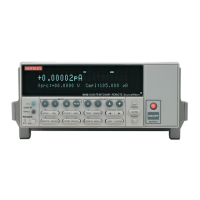14-10 Status Structure
Status byte and service request commands
The commands to program and read the Status Byte Register and Service Request Enable
Register are listed in Table 14-3. For details on programming and reading registers, see Pro-
gramming enable registers and Reading registers.
NOTE To reset the bits of the Service Request Enable Register to 0, use 0 as the parameter
value for the *SRE command (i.e. *SRE 0).
Programming example - set MSS (B6) when error occurs
The first command of sequence in Table 14-4 enables EAV (error available). When an
invalid command is sent (line 4), bits B2 (EAV) and B6 (MSS) of the Status Byte Register set
to 1. The last command reads the Status Byte Register using the binary format (which directly
indicates which bits are set). The command to select format (FORMat:SREGister) is docu-
mented in Table 14-2. To determine the exact nature of the error, you will have to read the Error
Queue. Refer to Queues.
Table 14-3
Status Byte and Service Request Enable Register commands
Command Description Default
*STB?
*SRE <NDN> or <NRf>
*SRE?
Read Status Byte Register.
Program the Service Request Enable Register:
<NDN> = #Bxx…x Binary format (each x = 1 or 0)
= #Hx Hexadecimal format (x = 0 to FF)
= #Qx Octal format (x = 0 to 377)
<NRf> = 0 to 255 Decimal format
Read the Service Request Enable Register
Note
Note: *CLS and STATus:PRESet have no effect on the Service Request Enable Register.
Table 14-4
Status byte programming example
Command Description
*CLS
*SRE 4
FORM:SREG BIN
*XYZ
*STB?
Clear Error Queue.
Enable EAV.
Select binary format.
Generate error.
Read Status Byte Register.

